Cytological pattern of cervical pap smears
DOI:
https://doi.org/10.3126/jpn.v8i1.19454Keywords:
Cervicitis, Conventional, Dysplasia, Intraepthelial, Papanicolaou, ReactiveAbstract
Background: Cervical cancer is one of the leading causes of morbidity and mortality. It can be preventable and diagnosed early with adequate and repetitive cytological screening by pap test. The conventional cervical cytological screening is the most common technique used throughout the world.
Materials and Methods: The present study is a retrospective study, carried out at Kantipur Dental College, Lagankhel polyclinic, Nivarak polyclinic and Grande city clinic and hospital services. Total 1999 cases were screened in two years period from shrawan 2072 to shrawan 2074.
Results: Out of 1999 smears, 56 cases (2.8%) were unsatisfactory/inadequate, 1884 (94.25%) smears were negative for intraepithelial lesion/malignancy, 115 (5.75%) smears showed epithelial cells abnormalities and 439(21.96%) smears were with reactive cellular changes associated with inflammation. Bacterial vaginosis (55.35%) was the most common etiology identified in 439 cases inflammatory smears. Total 310 (15.5%) cases showed moderate to severe atrophic changes in smear cytology. Among 18 follow up cases of carcinoma cervix, one case (0.2%) was identified as relapse case.
Conclusion: Bethesda system classification 2001found to be very useful screening method for early detection of epithelial cells abnormalities of cervix in nepali population. As all the cases of epithelial cells abnormities were of age above 30 years, Pap smear examination should begin in women at least at the age of 30 years. Large studies are required to estimate the pattern of cervical cytological abnormalities along with Human papilloma virus (HPV) strain detection in Nepalese population.
Downloads
Downloads
Published
How to Cite
Issue
Section
License
This license enables reusers to distribute, remix, adapt, and build upon the material in any medium or format, so long as attribution is given to the creator. The license allows for commercial use.




